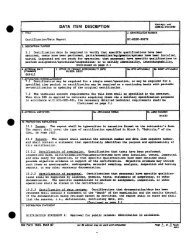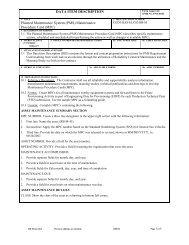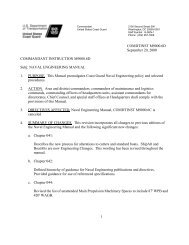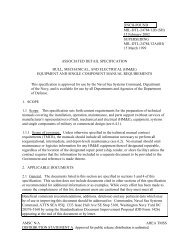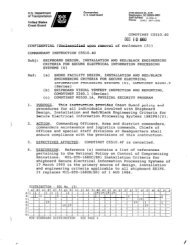comdtinst m2400.1f - US Coast Guard Response Boat-Medium
comdtinst m2400.1f - US Coast Guard Response Boat-Medium
comdtinst m2400.1f - US Coast Guard Response Boat-Medium
You also want an ePaper? Increase the reach of your titles
YUMPU automatically turns print PDFs into web optimized ePapers that Google loves.
6.B.4. Operational Areas. Operational areas have been designated to<br />
determine equipment carriage requirements for vessels and appropriate<br />
communication systems to employ for distress alerting and<br />
communications (see paragraph L below).<br />
(a) Area A1 - within range of shore based VHF stations<br />
(b) Area A2 - within range of shore based MF stations (excluding A1<br />
areas)<br />
(c) Area A3 - within the coverage area of geostationary satellites<br />
for maritime communications (excluding A1 and A2 areas)<br />
(d) Area A4 - outside the coverage area of geostationary satellites<br />
5. INMARSAT. Satellite communications may be used in both the<br />
ship-to-ship and shore-to-ship directions. The INMARSAT<br />
system, which uses geostationary satellites and operates in<br />
the 1.5 to 1.6 GHz bands, will provide a means of alerting<br />
from ships and for two way communications using radiotelephone<br />
and NBDP. Polar orbiting SARSAT satellites will provide a<br />
means of distress alerting and position location of EPIRBs in<br />
the 406 - 406.1 MHz band. Basic ship-board equipment will<br />
consist of a ship earth station, approved by INMARSAT<br />
(Standard A or C terminal), and satellite EPIRBs.<br />
6. HF. HF will provide long range communications in the<br />
ship-to-shore and shore-to-ship directions. In areas covered<br />
by INMARSAT, HF can be used as an alternative to satellite<br />
communications. Outside these areas it will provide the only<br />
communications capability. Frequencies have been designated<br />
in the 4,6,8,12 and 16 MHz bands to provide for distress<br />
alerts, safety calls and for passing distress and safety<br />
traffic. HF distress and safety traffic will be transmitted<br />
by radiotelephony and/or NBDP.<br />
7. DSC. DSC will be used for distress alerting and safety calling.<br />
Choice of the appropriate band to use will be determined by the<br />
geographic area to be covered and propagation conditions. Current<br />
planning is for ships using the HF option to maintain a watch on the 8<br />
MHz alerting frequency and one other HF frequency appropriate for the<br />
Area in which the ship is operating. The <strong>Coast</strong> <strong>Guard</strong> will use DSC<br />
primarily as a means of initiating a radiotelephone (voice) call.<br />
8. MF. MF will provide medium range communications in the ship-to-shore,<br />
ship-to-ship and shore-to-ship directions. Distress alerts and safety<br />
calls by DSC will be on 2187.5 kHz. Disresss and safety traffic by<br />
radiotelephony, including SAR coordinating functions and on scene<br />
communications will be on 2182 kHz. Distress and safety traffic by<br />
NBDP will be on 2174.5. Navigational and meteorological warnings<br />
using the NAVTEX system will be on 518 kHz. A complement of HF NBDP<br />
Channels will be available on 1 July 1991 to provide high sea maritime<br />
safety information. The frequency 490 kHz will be available at a<br />
later date to supplement NAVTEX in the shore-to-ship direction.<br />
6-2





